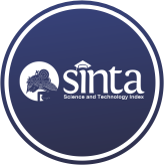Machine Learning for Tsunami Prediction: A Comparative Analysis of Ensemble and Deep Learning Models
(1) Universitas Katolik Indonesia Atma Jaya, Jakarta, Indonesia
(*) Corresponding Author
Abstract
Full Text:
PDFReferences
M. T. I. Khan, S. Anwar, S. A. Sarkodie, M. R. Yaseen, and A. M. Nadeem, “Do natural disasters affect economic growth? The role of human capital, foreign direct investment, and infrastructure dynamics,” Heliyon, vol. 9, no. 1, 2023.
P. Cui et al., “Scientific challenges of research on natural hazards and disaster risk,” Geogr. Sustain., vol. 2, no. 3, pp. 216–223, 2021.
M. T. Chaudhary and A. Piracha, “Natural disasters—origins, impacts, management,” Encyclopedia, vol. 1, no. 4, pp. 1101–1131, 2021.
L. Velotti, “Natural Hazards: Tsunamis,” in Encyclopedia of Security and Emergency Management, Springer, 2021, pp. 693–696.
H. A. Bachay, A. H. Aldefae, S. L. Zubaidi, W. H. Humaish, and E. K. Sinichenko, “Tsunami Waves, Causes and Its Implications: A Review,” Geotech. Eng. Sustain. Constr. Sustain. Geotech. Eng., pp. 63–77, 2022.
J. S. Becker et al., “Earthquakes and tsunami,” in Routledge handbook of environmental hazards and society, Routledge, 2022, pp. 13–32.
T. Srinivasa Kumar and S. Manneela, “A review of the progress, challenges and future trends in tsunami early warning systems,” J. Geol. Soc. India, vol. 97, pp. 1533–1544, 2021.
J. Behrens et al., “Probabilistic tsunami hazard and risk analysis: A review of research gaps,” Front. Earth Sci., vol. 9, p. 628772, 2021.
P. M. De Martini et al., “The Mediterranean Sea and the Gulf of Cadiz as a natural laboratory for paleotsunami research: Recent advancements,” Earth-Science Rev., vol. 216, p. 103578, 2021.
X. Cao, Z. Liu, C. Hu, X. Song, J. A. Quaye, and N. Lu, “Three-Dimensional Geological Modelling in Earth Science Research: An In-Depth Review and Perspective Analysis,” Minerals, vol. 14, no. 7, p. 686, 2024.
Z. Ma and G. Mei, “Deep learning for geological hazards analysis: Data, models, applications, and opportunities,” Earth-Science Rev., vol. 223, p. 103858, 2021.
L. Xu, N. Chen, Z. Chen, C. Zhang, and H. Yu, “Spatiotemporal forecasting in earth system science: Methods, uncertainties, predictability and future directions,” Earth-Science Rev., vol. 222, p. 103828, 2021.
C. M. Liu, D. Rim, R. Baraldi, and R. J. LeVeque, “Comparison of machine learning approaches for tsunami forecasting from sparse observations,” Pure Appl. Geophys., vol. 178, no. 12, pp. 5129–5153, 2021.
E. Cesario, S. Giampá, E. Baglione, L. Cordrie, J. Selva, and D. Talia, “A parallel machine learning-based approach for tsunami waves forecasting using regression trees,” Comput. Commun., vol. 225, pp. 217–228, 2024.
A. Pourzangbar, M. Jalali, and M. Brocchini, “Machine learning application in modelling marine and coastal phenomena: a critical review,” Front. Environ. Eng., vol. 2, p. 1235557, 2023.
X. Shu and Y. Ye, “Knowledge Discovery: Methods from data mining and machine learning,” Soc. Sci. Res., vol. 110, p. 102817, 2023.
Y. Zhao and D. Gorse, “Earthquake prediction from seismic indicators using tree-based ensemble learning,” Nat. Hazards, vol. 120, no. 3, pp. 2283–2309, 2024.
J. Jia and W. Ye, “Deep Learning for Earthquake Disaster Assessment: Objects, Data, Models, Stages, Challenges, and Opportunities,” Remote Sens., vol. 15, no. 16, p. 4098, 2023.
W. Khan, A. Daud, K. Khan, S. Muhammad, and R. Haq, “Exploring the frontiers of deep learning and natural language processing: A comprehensive overview of key challenges and emerging trends,” Nat. Lang. Process. J., p. 100026, 2023.
Z. Ma, G. Mei, and N. Xu, “Generative deep learning for data generation in natural hazard analysis: motivations, advances, challenges, and opportunities,” Artif. Intell. Rev., vol. 57, no. 6, p. 160, 2024.
T. Sharma, A. Singhal, K. Kundu, and N. Agarwal, “Machine Learning/Deep Learning for Natural Disasters,” in Applications of Artificial Intelligence, Big Data and Internet of Things in Sustainable Development, CRC Press, 2022, pp. 91–121.
M. A. Ganaie, M. Hu, A. K. Malik, M. Tanveer, and P. N. Suganthan, “Ensemble deep learning: A review,” Eng. Appl. Artif. Intell., vol. 115, p. 105151, 2022.
R. Triatmadja and others, “Vegetation-based approached for tsunami risk reduction: Insights and challenges,” Prog. Disaster Sci., p. 100352, 2024.
M. Esposito, L. Palma, A. Belli, L. Sabbatini, and P. Pierleoni, “Recent advances in internet of things solutions for early warning systems: A review,” Sensors, vol. 22, no. 6, p. 2124, 2022.
H. Li, “Deep-Ocean Assessment and Reporting of Tsunamis (DART) BUOY,” in Encyclopedia of Ocean Engineering, Springer, 2022, pp. 306–314.
Y. Zhao, S. Lv, and P. Liu, “Advances in earthquake prevention and reduction based on machine learning: a scoping review (July 2024),” IEEE Access, 2024.
S. K. Nezhad, M. Barooni, D. Velioglu Sogut, and R. J. Weaver, “Ensemble neural networks for the development of storm surge flood modeling: A comprehensive review,” J. Mar. Sci. Eng., vol. 11, no. 11, p. 2154, 2023.
P. Govindarajan, N. Venkatanathan, and others, “Towards real-time earthquake forecasting in Chile: Integrating intelligent technologies and machine learning,” Comput. Electr. Eng., vol. 117, p. 109285, 2024.
Y. Li and K. Goda, “Risk-based tsunami early warning using random forest,” Comput. & Geosci., vol. 179, p. 105423, 2023.
E. K. Sahin, “Comparative analysis of gradient boosting algorithms for landslide susceptibility mapping,” Geocarto Int., vol. 37, no. 9, pp. 2441–2465, 2022.
E. Karampotsis, K. Kioskli, A. Tsirimpa, G. Dounias, and A. Polydoropoulou, “Understanding evacuation behavior for effective disaster preparedness: a hybrid machine learning approach,” Nat. Hazards, pp. 1–39, 2024.
E. CHERIF, “Deep learning-enhanced satellite-based Flood detection for early Warning and prevention,” University Larbi Tébessi--Tébessa, 2024.
M. H. Al Banna et al., “Attention-based bi-directional long-short term memory network for earthquake prediction,” IEEE Access, vol. 9, pp. 56589–56603, 2021.
G. Xu et al., “Machine learning in coastal bridge hydrodynamics: a state-of-the-art review,” Appl. Ocean Res., vol. 134, p. 103511, 2023.
C. Zhou, M. Ye, Z. Xia, W. Wang, C. Luo, and J.-P. Muller, “An interpretable attention-based deep learning method for landslide prediction based on multi-temporal InSAR time series: A case study of Xinpu landslide in the TGRA,” Remote Sens. Environ., vol. 318, p. 114580, 2025.
A. S. Albahri et al., “A systematic review of trustworthy artificial intelligence applications in natural disasters,” Comput. Electr. Eng., vol. 118, p. 109409, 2024.
J. Deng, G. Gong, G. Zhou, M. Yan, and L. Li, “A gated feature fusion network with meta-encoder and self-calibrating cross module for building change detection in remote sensing images,” IEEE Trans. Geosci. Remote Sens., 2024.
P. L. Ford, “Earthquakes Historical Data and Live Data.” Kaggle, 2023. https://www.kaggle.com/datasets/patricklford/earthquakes-historical-data-and-live-data/data
DOI: https://doi.org/10.30645/kesatria.v6i1.572
DOI (PDF): https://doi.org/10.30645/kesatria.v6i1.572.g567
Refbacks
- There are currently no refbacks.
Published Papers Indexed/Abstracted By:














